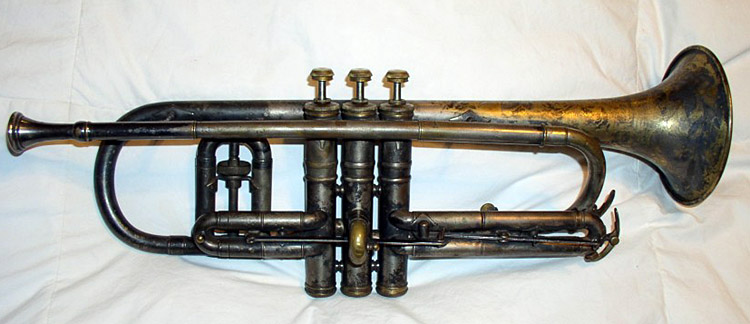Conn 90A Victor (with mechanism)

Date: 1924. Owned by Todd Metzger
The 90A Victor is a small bore variant of the well known 80A Victor. The only way I personally can tell the difference between the 80A and the 90A is the model number stamped under the leadpipe. It is interesting to note that this 1924 instrument does have the model number stamped under the leadpipe, proving Conn did that at least as early as 1924 (the owner sent me a picture of it). The bore of the 90A Victor us ½, which is 0.425". Also notice that the 90A is equipped with the "mechanism", which automatically extends the valve slides the right amount when the main tuning slide is pulled out from Bb to A. The bell size is the same as the 80A, 4 5/8". It is a quarter of an inch longer that the 80A, which is due to the smaller bore. Another interesting feature of the 90A which it shares with the 80A's produced at the time is that the valve springs "are adjustable to suit the finger-strength or temperament of the player". Read the booklet Conn included with these instruments, entitled What you should know about this instrument for more on the "mechansim", the micro-tuning mechanism (a.k.a. opera glass tuning slide) and the adjustable spring strength. This instrument is silver plated, with the silver having turned black over time (the owner promised me a new picture when it is cleaned up).
I have learned that the third slide without the finger ring to adjust the pitch of a low D and C# is slightly longer than it is on modern instruments. On modern instruments the low Eb is in tune, but the low D and C# are quite sharp. On these older cornets with the longer third slide no finger ring the Eb is a bit flat and the D and C# are slightly sharp, but not as sharp as they are on later instruments. It was thought that the flat Eb and slightly sharp D and C# were within the abilities of the player to lip into tune.
As far as I can tell at this point, all Conn cornets built before 1958 take a short shank cornet mouthpiece as opposed to the 2¾" "Bach-style" long shank cornet mouthpiece. The long shank cornet mouthpieces won't properly fit a pre-1958 Conn cornet and won't give the proper intonation or playing characteristics of a short shank cornet mouthpiece. All of Conn's "Connstellation" cornet mouthpieces are long shank mouthpieces. The "Improved Precision" Conn mouthpieces such as the Conn 4 are long shank if there is a "ridge" halfway down the shank, and short shank if there is no ridge (in which case it is a "Precision" mouthpiece). All Conn cornet mouthpieces built before the "Improved Precision" series (ridge), such as the "Precision" series (no ridge) are short shank mouthpieces.
What Conn said about the "Victor" in 1927:
Victor cornets are setting the standard for the cornet world. Easy speaking, marvelously flexible, perfect in
intonation and possessing unsurpassed beauty of tone. It is not strange they are being played by more world artists
than any other cornet in the world. Now available in two bores - the 4A Small bore and the 80A Large bore.
One of these two is the cornet you've been whishing you could sometime possess; it all depends upon what your
engagement demands of you, which one you choose.